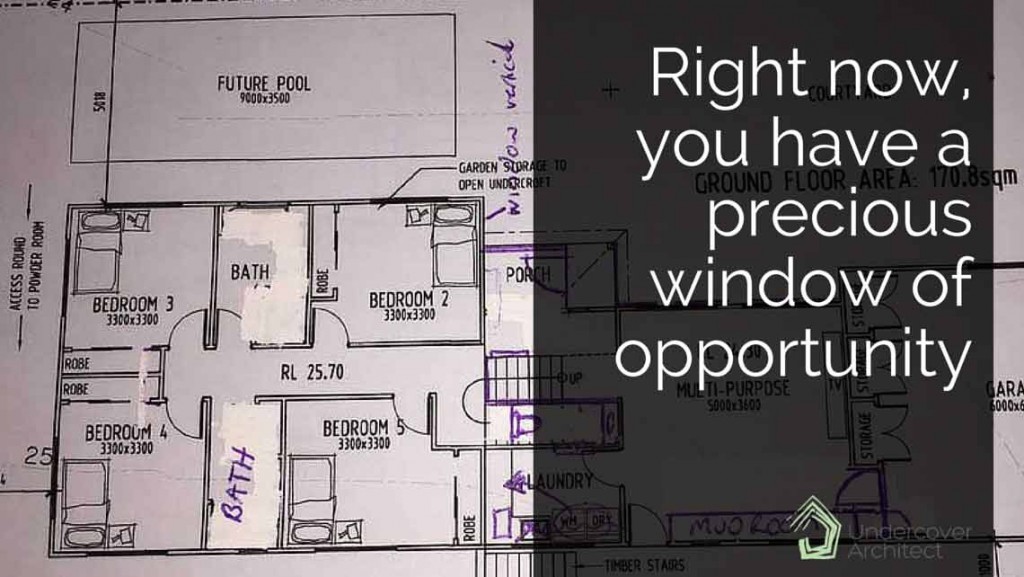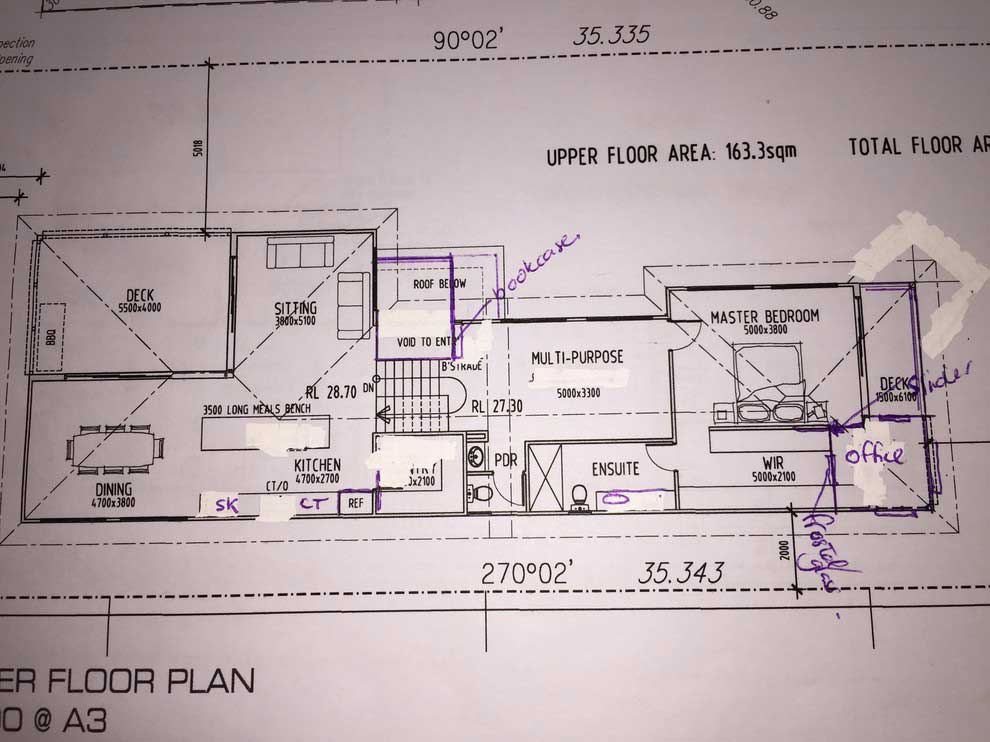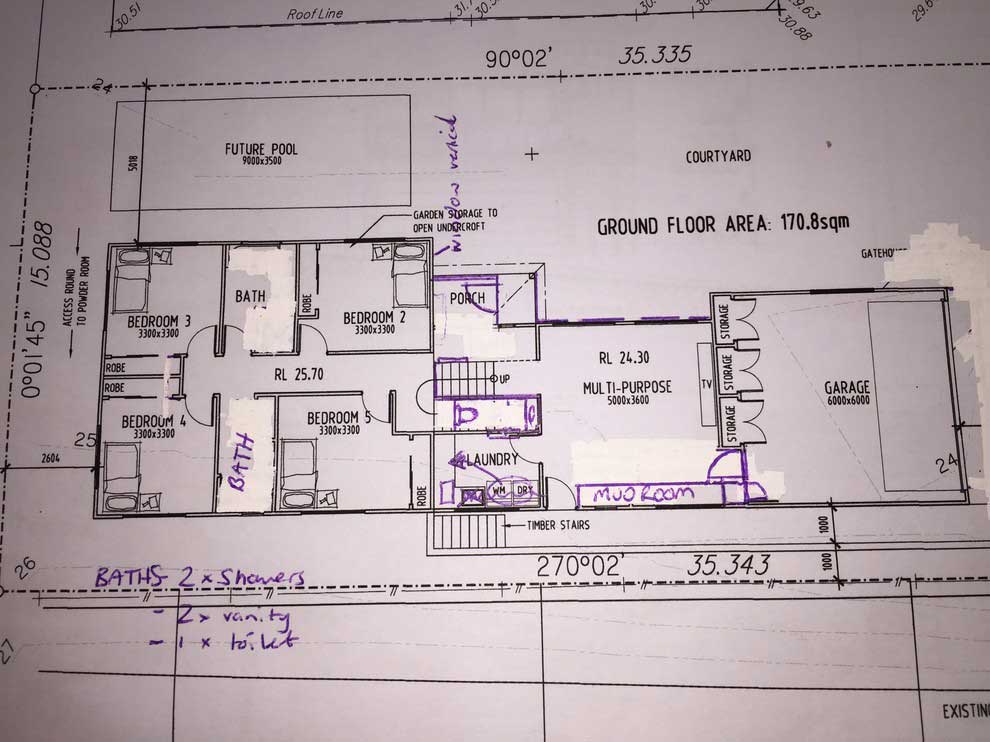
Often homeowners are in a race to get their renovation or building floor plan design done, they don’t maximise the opportunity to get it right. Don’t miss the chance.
Have you spent anytime on Houzz? It’s a fantastic resource when building and renovating your home. Lots of design inspiration, product ideas, and finding professionals to work with.
They also have an Advice section. It operates like an online forum, where homeowners can post questions about – well, anything – and receive advice. This includes “Design Dilemmas” and homeowners post their floor plans, seeking ideas or feedback on specific concerns.
It’s amazing to see the advice and feedback provided – both by non-professionals and professionals. What I’m often surprised by is how much time non-professionals spend drawing up ideas, and making suggestions on these Design Dilemmas.
Recently a woman posted some photos of her house-plan, asking for comment on the bathroom layout and design.
These are the floor plans she posted, and her question …


“Hi all
We are planning a demo and rebuild. It’s been a slow process with 2 extra children being added to the mix over the time :-). Thankfully we hadn’t rushed into a 3-4 bed with just 1 living!
Anyway I think we’ve almost completed the floor plans of a 2 x split level home. I need some help from you HOUZZ’ERS as to how best layout the kids bathroom spaces. We’ve put all the kids bedrooms together and they have access to an extra toilet down a 1/2 flight of stairs. I am wanting to use the 2 spaces named BATH to allow the kids to get ready simultaneously., some kind of open plan?? The bathroom dimensions are not marked on the plan, however the plan is 1:100 @a3. I’m wanting to include 2 vanities with plenty of storage (thinking 2 teenage girls), 1 shower over bath (still have toddlers), 1 separate shower and a separate toilet, if there is space for a linen cupboard that would be fantastic, otherwise I can find an alternative by sneaking space into the end of the hall.
I would also love to hear any other thoughts you might have about the floor plans, improvements, mistakes, errors!! ??? We only get once chance at this!!”
A string of comments ensued. Alternative ideas for the bathroom layout were drawn up by strangers. Comments and feedback provided. By the time I saw the post, there was a lot of conversation!
When I looked at the design of the floor plan, there was much more to consider than the bathroom layout to help it be a great plan to live in. Functional, practical, enjoyable and convenient. A design that works now, and always.
I’ll put the link to the Houzz Design Dilemma at the end of this post (incase you’re interested). However, I thought I’d share it here as tips for you to consider when you are designing your home or renovation, so you can make the most of your design overall.
Whilst your home is lines on a page, change is cheap.
Whilst the design of your home is a set of drawings, you have a precious window of opportunity to get it right – before you make all these choices and decisions permanent ones you are forced to live with.
It’s hard to be patient. Usually by the time you get to the point of having your home design drawn up, you’ve been dreaming and planning about if for a long time. Looked through truckloads of magazines, spent time online, figured out how you want things to be. The drawing seems to be a fait au complit … that is ‘a done deal’ just waiting for you to push ‘go’ and make it the home you’ll then be living in.
It’s at that point that I would recommend you say ‘wait’ instead of ‘go’. This is the sliver of time that a lot of homeowners don’t capitalise on.
In their desperation get it done, they don’t maximise the opportunity to get it right.
What I’m talking about here is NOT analysis paralysis. And I’m not talking about designing by committee and asking every member of family, mum from school or random strangers on Houzz whether you’ve created the best result.
However, a second opinion from an experienced professional, or even testing a couple more ideas with the designer you’re working with, is a good way to be sure you’ll be making the most of your time, money and the home you’re creating.
Better to take a little pause now and think ‘I’ll just check …’, than to stand in your finished home saying ‘I wish we had …’.
Always draw furniture on your floor plans
The thing I noted about this floor plan was that there was furniture drawn in certain rooms, and not in others.
If you’re reviewing floor plans for your home, please ensure they have furniture (drawn to scale) shown in them.
This is an incredible tool in understanding how you can move through your home. Check the following once the furniture is drawn in:
- What do you see when you walk into spaces? Will that be inviting, obtrusive, private, messy?
- How do you move from one space to another? Will you have to weave through furniture to circulate through?
- Is furniture blocking access from inside to outside – visual and physical?
I suggested to this homeowner that the multi-purpose rooms appeared to be space for space’s sake. They seemed to lack through and intention for their use, and that circulation occurring through or across them would compromise their functionality, furnishability and sense of space.
What I surmised from this (and perhaps this is an incorrect assumption) was that furniture wasn’t shown in these multi-purpose rooms because it was too difficult to determine how they’d be furnished.
Once furniture is put in these rooms, their usefulness (or lack of it) will show up.
That’s the beauty of drawing furniture on a plan – it’s a great test.
Weigh up short term “WOW” with long term functionality
When you have a great view or outlook from your home, and access to it is improved in the upper level of your house, it can be an obvious choice to locate your living areas upstairs and make the most of enjoying that view every day.
That was the case in this design. The owner was following suit on a lot of the homes in the area which put the living areas upstairs to capture the view, and bedrooms downstairs.
However, in creating a family home, the inconvenience of having to take a packed lunch each time your children want to be in the garden or pool (if you have one) can be infuriating. Because you’re only doing that. You’re stopping whatever you’re doing, and taking the kids to play or swim. Until they’re old enough to do this unsupervised, that’s what you’ll be doing.
One of the biggest challenges with homes, especially in Brisbane where this home is located, is that they are completely divorced from their gardens because they have prioritised the view.
As a mum to 3 young kids, and having helped truckloads of clients with family homes (and families of all ages), I know this for sure … the connection to garden … the ability to move in and out with ease, safety and enjoyment … is one of the things that pays dividends long term.
Supervision of gardens from indoor living areas has such a dramatic impact on the usability of the home overall, and your ability to get stuff done whilst kids play etc.
With clever design, you can have both convenience and enjoyment of the view. Your home dictates the lifestyle you lead in it.
It’s hard to imagine because the view is so impressive now. And making the most of it will add value to the home too.
You can do both … have function and value. And once you’ve lived in the home for a while, the view will be less ‘wow’ and the inconvenience of how you have to live will be more ‘what was I thinking’.
Mentally visualise how you’ll use the home you have drawn in front of you
This means looking at your floor plan and thinking about the activities that take place in everyday life. How will they work? Could it be simpler, more convenient or better? Some examples include …
- When you arrive home in the car, and unload kids (maybe a baby on your hip), schoolbags and shopping … how do you need to move through the home and put away all those items. Is circulation space sufficient, and easy to navigate? Is storage where it needs to be?
- When the kids are playing outside, can you be in the kitchen preparing food? Or sitting on the sofa chatting to hubby or a friend? And still safely supervise and get to them easily?
- If you’re entertaining guests, how do they arrive at your home? How do they walk through it to where you’ll be hanging out? What do they see on the way? Where do they go to the loo? What will they see on the way to it?
- When you open the door to a stranger, what to they get to see?
- If you have kids in the garden, or in the pool, where will they go to the loo? Will it involve muddy or wet footprints across carpeted areas?
When you’re dashing through the home, gathering things in a panic to get out of the house because you’re running late, screaming at the kids, grabbing what you need, and heading out to the car (wait, is that just me?) … is that easy to do? Or are you zig-zagging all over the house to get what you need and get out?
(Can you see in this floor plan, how you’ll arrive in the lower floor multi-purpose area, and need to traverse it – and whatever is in it – to get upstairs?)
When I looked at the floor plan of this home, I had these recommendations:
- a study nook or somewhere near living areas where kids’ use of computers can be supervised, and you have a home ‘command station’ of sorts is also good
- the ability to acoustically close off a lounge area – which is the kids’ TV / play area is very helpful for long term use
- I wouldn’t split the bathrooms – I understand what the homeowner was seeking to achieve, but re-planning to group them in one area will consolidate plumbing and the wet area finishes, and be more efficient (and economical in cost and area) overall
- consider creating a floor plan that works with access / circulation etc between living areas and garden, and then having an upper floor living area or retreat where you can enjoy the view
- doing a budget check. There are A LOT of wet areas in this home because of how they’re being distributed throughout the floor plan.
What is missing from your floor plan?
What I often see is that the stress of making choices and decisions about your home design can get overwhelming.
- it can involve large sums of money
- it can feel really permanent
- there’s a fear of ‘stuffing things up’
- you’re probably living in conditions that aren’t that ideal whilst you plan your new home
So, in that state of overwhelm, it can be tempting to make decisions faster. To rip it off like a bandaid. Charge forward and through and just get it over with.
Surely it will still be ok won’t it? I mean, you can spend forever thinking about these things. At some point, you just have to make a decision and choose, don’t you? Otherwise it’ll never get built!
Yes, you do have to choose.
Choose though, with your eyes open. In an informed and educated way. With guidance and advice from someone you trust. Safe in the knowledge you’ll get it right.
Because getting it right, and getting it done, can (and should) go hand in hand when it comes to your home.
Resources:
There’s quite a few free online tools that can help you plan rooms, and add furniture.
Head to these links as a start to see what suits you …
Floor Planner | Homestyler | Ikea Home Planner
If you’re old school … then google “Furniture for home plans” under Google Images, you’ll also see many examples that you can print, cut out and manually arrange on a floor plan – just make sure you’re working at the same scale the drawings are at.
If you’d like to see the original Design Dilemma on Houzz, head here.
 With over 30 years industry experience, Amelia Lee founded Undercover Architect in 2014 as an award-winning online resource to help and teach you how to get it right when designing, building or renovating your home. You are the key to unlocking what’s possible for your home. Undercover Architect is your secret ally
With over 30 years industry experience, Amelia Lee founded Undercover Architect in 2014 as an award-winning online resource to help and teach you how to get it right when designing, building or renovating your home. You are the key to unlocking what’s possible for your home. Undercover Architect is your secret ally
quite nice. well done. thanks for the sharing. keep it up.
Thanks for your feedback,
– Amelia, UA
Hi Amelia, I love your blog, it’s been really helpful for us. We are currently designing a home in Melbourne on a downward sloping block. I noted your comments above, but I was wondering what would you suggest for a split level home where the entrance is on the upper level and we have a lower level that connects to the garden? We currently placed the open plan living, dining, kitchen on the upper level with a balcony overlooking the garden, so that it’s the same level as the entry door. We have stairs inside the house to go downstairs where kids bedrooms and rumpus are, as well as an outdoor stair from the balcony to the garden.. In this case, would it make sense to keep the open plan living, dining and kitchen on the upper level, so our guests do not need to go through our bedrooms to go to the main area? (and it also has a nice view from the upper level). Thank you.
Hi Evelyn,
Thanks for your feedback – so glad you’ve found UA helpful. I would really recommend you listen to the podcast episodes on Designing for Sloping Blocks, and Designing for Upper Level Views. They’ll be really helpful in making decisions about where to best locate rooms etc. You can find them both indexed here >>> https://undercoverarchitect.com/podcast-how-to-design-for-difficult-sites/
Best wishes for your project,
Amelia, UA
are you able to help us with a floorplan we are currently working with. we are strugling to make it more efficient
Hi Soraiya,
Thank you for being at the Undercover Architect website. Please note that Undercover Architect isn’t a traditional architectural practice, and Amelia doesn’t provide 1:1 design services.
The only way to access her input on a project is to join her HOME Method online program, and then purchase upgrades (Design Reviews or Zoom Consultations).
Please let me know if you have any questions, we are happy to help.
– Team UA
A great read for anyone in the home design process
Hi Daniil, thanks so much for your kind feedback!